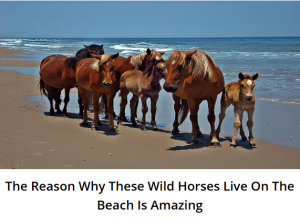
The Amazing Reason Why Wild Horses Live on the Beach
The sight of wild horses galloping freely along the sandy shores of remote beaches is an awe-inspiring spectacle. These majestic creatures, often seen in small, close-knit herds, have sparked curiosity and admiration for centuries. How did they end up living in such an unusual habitat? What sustains them on the salty shores where few other large mammals roam? The answer to why wild horses live on the beach is deeply intertwined with history, survival instincts, and ecological adaptation.
A Legacy of Shipwrecks and Early Settlers
One of the most compelling explanations for the presence of wild horses on coastal shores, particularly in places like Assateague Island, the Outer Banks of North Carolina, and the Sable Island in Canada, lies in historical accounts of shipwrecks and colonial expeditions. Centuries ago, European explorers and settlers brought horses to the New World, primarily as a means of transportation and labor. These horses, often of Spanish descent, were carried aboard ships crossing the treacherous Atlantic Ocean.
Storms, piracy, and navigational errors frequently led to shipwrecks along the eastern seaboard. In several instances, horses that were being transported managed to swim ashore and survive. Over time, these stranded horses formed small herds and adapted to the harsh coastal environment, where they thrived despite the challenges presented by the shifting sands and limited fresh water.
In some cases, colonists deliberately abandoned horses on islands, either due to economic downturns or as a means of reducing the burden of feeding and caring for them. Once released into the wild, the horses relied on their natural instincts to survive, giving rise to the resilient beach-dwelling populations that exist today.
Adaptations to a Harsh Environment
Living on a beach presents a unique set of challenges that these horses have remarkably overcome. Unlike lush inland pastures, coastal environments are often barren, with limited access to fresh water and nutrient-rich vegetation. Despite this, wild horses have developed a range of adaptations that enable them to thrive in such extreme conditions.
Dietary Adjustments
Wild beach horses primarily feed on the sparse vegetation found in their surroundings. Their diet consists mostly of dune grasses, salt-marsh cordgrass, and other hardy plants that can withstand sandy soils and salty air. These plants provide enough sustenance to support the herds, even though they offer fewer nutrients than the rich grasses found inland.
Because their diet contains high levels of salt from the coastal plants, these horses must drink more water than their inland counterparts. Finding fresh water can be a challenge, but they have adapted by seeking out rainwater pools, digging into the sand to access underground freshwater sources, and utilizing marshy areas where freshwater accumulates.
Smaller Stature and Resilience
Over generations, many wild beach horse populations have evolved to be slightly smaller than their inland relatives. This is partly due to the limited resources available in their environment, which has led to a form of natural selection favoring smaller, more energy-efficient individuals. These horses tend to be stocky, with strong hooves that allow them to navigate shifting sands without difficulty.
Survival Strategies
Unlike domesticated horses, which rely on human caretakers, wild beach horses have honed survival strategies that help them navigate their harsh environment. They have learned to regulate their body temperature by seeking shade during the hottest parts of the day and using their strong social bonds within the herd to protect each other from threats.
The Role of Conservation Efforts
The continued existence of wild beach horses has been a subject of conservation and debate. In many regions, conservationists work tirelessly to ensure the protection of these unique herds while balancing the ecological impact they have on fragile dune ecosystems.
One of the biggest challenges facing wild beach horses today is habitat loss due to human development and tourism. Increased human activity in coastal areas threatens their natural habitat and can disrupt their traditional movement patterns. To combat this, organizations have implemented conservation programs that focus on habitat restoration, responsible tourism, and population management.
Human Interaction and Protection Measures
Many wild beach horse populations are now protected by law, ensuring that human interference remains minimal. Visitors to areas like Assateague Island and the Outer Banks are encouraged to admire these horses from a distance, as feeding or approaching them can disrupt their natural behaviors and even endanger their well-being.
Some conservation groups also engage in controlled population management to prevent overpopulation, which can lead to resource depletion and malnutrition within the herds. Methods such as birth control programs have been introduced to maintain a stable and sustainable population without resorting to relocation or removal.
Cultural and Historical Significance
Wild beach horses hold deep cultural and historical significance for many communities. They are celebrated as symbols of freedom, resilience, and natural beauty. In places like Chincoteague, Virginia, annual events such as the Pony Swim attract thousands of visitors eager to witness these majestic creatures in their natural environment.
Stories and legends surrounding wild horses have also become an integral part of local folklore. Many believe that these horses embody the spirit of adventure and survival, reminding people of their connection to the past and the untamed beauty of nature.
Conclusion
The reason why wild horses live on the beach is nothing short of extraordinary. Their presence is a testament to centuries of survival, adaptation, and historical events that have shaped their existence. Whether they are descendants of shipwrecked survivors or the remnants of early colonial settlements, these horses have carved out a niche in one of the most unexpected habitats on Earth.
As conservation efforts continue to protect and preserve their way of life, these incredible creatures will remain an enduring symbol of resilience and freedom, captivating the hearts of all who witness their untamed beauty along the shores they call home.